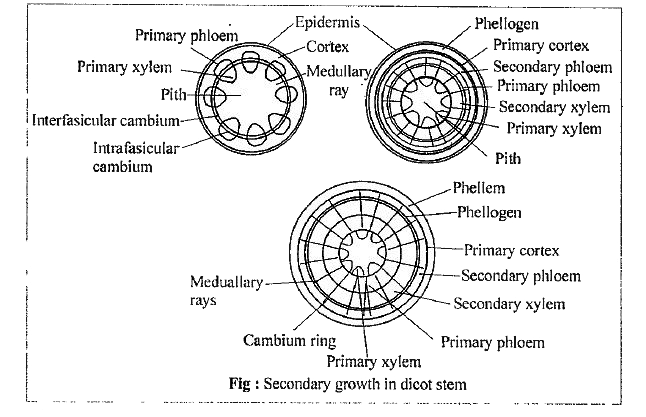Explain the process of secondary growth in the stems of woody angiosperms with the help of schematic diagrams. What is its significance?Solution in Punjabi
secondary xylem and secondary phloem.
(b) Ray intials : These are isodiametric in shape and produce parenchymatous rays in the secondary xylem and phloem.
(iii) Acitivity of vascular cambium : The cells of cambial rings always remain in a continuous state of division. They mostly divide periclinally and produce new cells towards both sides, Out of two cells, one cells forms secondary tissue and other remains as cambial cell.
(iv) Formation of secondary xylem and secondary phloem : The fusiform initial cells of vascular cambium divide periclinicaly and produce new cells toward both sides. The outer side cells are differentiated into secondary phloem while inner side cells are differentiated into secondary xylem.
(v) Formation of secondary medulary rays : The ray initial of the vascular cambium divide by tangential division and add new cell. These cell form the secondary medullary rays between the secondary xylem and secondary phloem. These are responsible for radial conduction of solutes
(vi) Formation of annual ring (growth rings) : The activity of cambium is under the control of many physiological and environmental factors. In temperate regions, climate condition are not uniform throughout the year. In spring the cambium is very active and produce a large number of xylary elements with wider vessels. The wood formed during this season is known as spring wood. In autumn, the cambium is less active and form fewer xylary elements. The xylary vessels are narrow and thick walled. The wood formed in winter is known as autumn wood or late wood. The two kinds of wood that appear as alternate concentric rings are known as annual rings.

Significance of secondary growth :
(i) It helps the plant in increasing its girth.
(ii) Annual rings are formed as a result of cambial activity. These are useful in determining age of plant.
(iii) Various protective coverings are formed in the stem after secondary growth. For example, lenticles, bark, etc.
Similar Questions
Explain the process of secondary growth in stems of woody angiosperm with help of schematic diagrams. What is the significance?
View SolutionExplain the process of secondary growth in stems of woody angiosperm with help of schematic diagrams. What is the significance?
View SolutionExplain the process of secondary growth in stems of woody angiosperm with help of schematic diagrams. What is the significance?
View SolutionExplain the process of secondary growth in stems of woody angiosperm with help of schematic diagrams. What is the significance?
View SolutionExplain the process of secondary growth in the stems of woody angiosperms with the help of schematic diagrams. What is its significance?
View SolutionExplain the process of secondary growth in stems of woody angiosperm with help of schematic diagrams. What is the significance?
View SolutionWhat is secondary growth? Illustrate this process in dicot stems.
View SolutionExplain the process of secondary growth in the stems of woody angiosperms with the help of schematic diagrams. What is its significance?
View Solution
